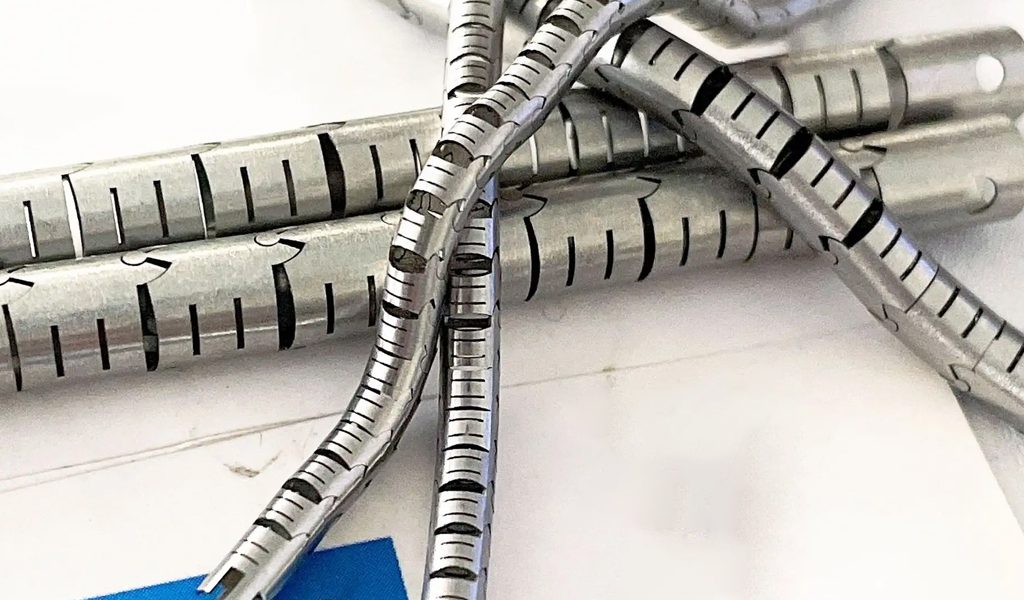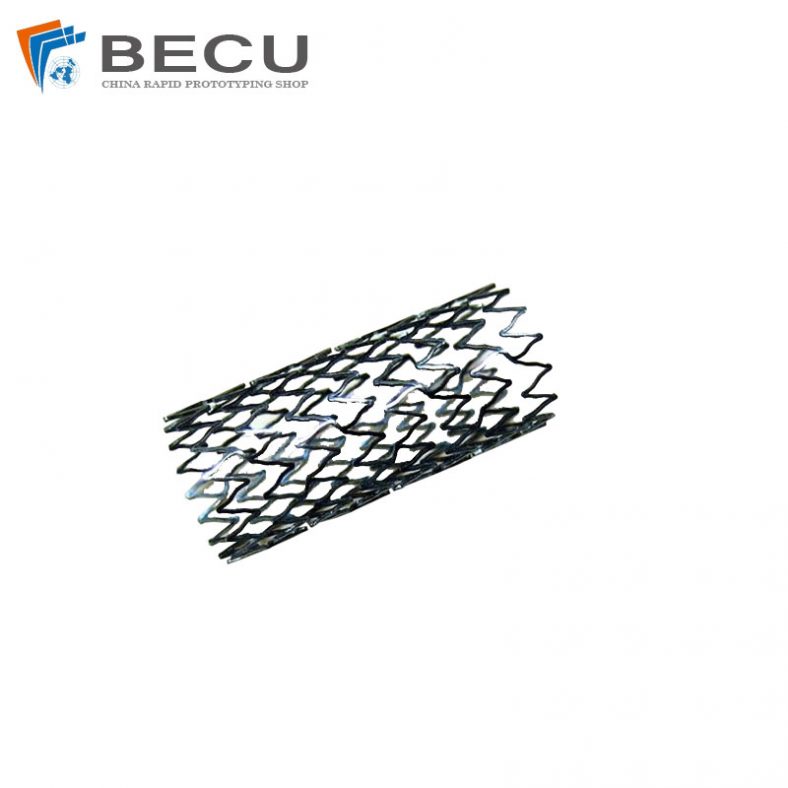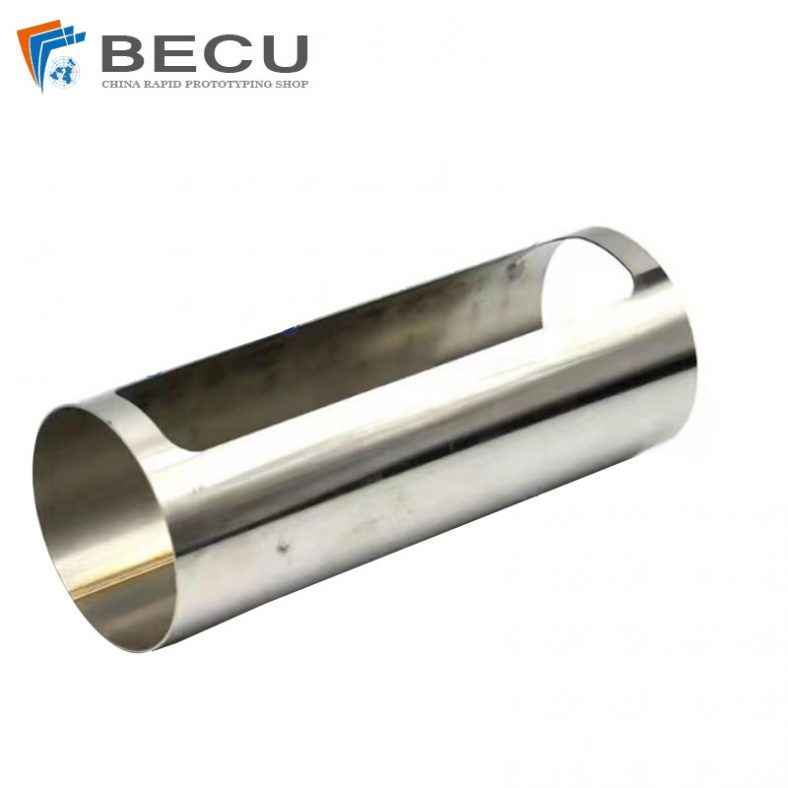Laser Cutting For Hypotube

Hypotube is a long metal tube with micro-engineered features throughout its entire length. It is an important component of catheters used in minimally invasive treatments and is used with balloons and stents to open blocked arteries. The balloon portion of the catheter is attached to the distal end of the hypotube. The hypotube enters the human body and pushes the balloon along the long and complex blood vessels toward the blocked artery. During this process, the hypotube needs to avoid kinks while being able to smoothly travel (propulse, track, and rotate) within the human body structure.
The working principle of a hypotube is based on the interaction of electrons in a strong electric field. In simple terms, the hypotube inputs microwave signals into a helix (also known as an electron gun), and then, through a high-frequency electric field, the electrons are formed into a beam. Subsequently, this electron beam is injected into the hollow intermediate cavity. In this cavity, interaction between electrons and the electric field occurs, resulting in the formation of high-power microwave signals. Finally, the output microwave signals are released from the output end of the hypotube.
In the medical field, hypotube are widely used in medical imaging equipment such as computerized tomography (CT scans) and magnetic resonance imaging (MRI). They can provide high-power microwave signals used for heating and exciting the nuclear spins in magnetic resonance, thereby generating images.
Hypotube must traverse complex and winding paths, thus requiring specific bending radii and flexibility. Laser cutting provides a variety of cutting geometries that contribute to flexibility, torque, and compression. Advanced laser cutting profiles can be utilized for controlled high-load conduit applications.
Hypotube Laser Cutting Service – Medical Laser Cut Hypo Tube
Be-Cu manufactures laser-cut hypotubes designed to provide increased flexibility, improved torque characteristics, or a combination of both for catheter applications. Laser cutting can also be employed to restrict axial stretch. Utilizing various cutting patterns allows us to adjust the flexibility and torque properties along the tube’s length to meet your specifications.
| Typical Kerf Width | Material Length | Wall Thickness | Part Length | Tolerance Control |
|---|---|---|---|---|
| 15~30um | up to 10′ | from .0007″ to .050″ | from .005″ to 10′ | ≤±5um |
Polymer ends may extend beyond the laser-cut surfaces, offering atraumatic tips on the distal end and ensuring better attachment to metal components or other polymers on the proximal end.Our Femtosecond laser cut hypotubes can be combined with PTFE liners, multi-durometer jackets, and channels within the tubing wall to facilitate deflectable tip catheters.
Laser-cut hypotubes provide performance comparable to coil-reinforced tubing or braid-reinforced tubing. Each method has its advantages, and we can recommend the most suitable option for your application, considering performance, cost, and other factors.Be-Cu is here to guide you in choosing the best reinforcement method to meet your needs.

Be-Cu now offers various hypotube supply options to meet our customers’ ever increasing design demands. Be-Cu can source any other material on request for prototyping and production runs of custom hypotubes. If you have special material needs, please contact us to provide you with a reliable solution.The specific type of hypotube can vary based on its intended use and the materials used in its construction. Here are a few common types:
Whether you need 10 custom parts, or 1,000,000, our precision machine shop can help maintain the quality and help you manage your supply chain efficiently. If precision and attention to detail are vital for the success of your medical industry project, we can deliver to your exact specifications.
Benefits of Be-Cu Flexi Hypotube Laser Cutting
Be-Cu has experience with supplying various laser cut patterns on flexi hypo tubes to provide our customers with the right flexibility solution to their cardio & endo vascular delivery device needs.
Strong Adaptability
- Laser cutting, drilling and grooving precision processing capabilities with centripetal opening characteristics for equal-diameter tubes
- Can process various alloy materials such as 304&316L&Ni-Ti&L605
- Compatible with precision thin-walled tube clamping systems such as precision D-type chucks & ER series chucks & three-jaw chucks
- Combined precision thin-walled tube bushing support system using adaptive shape tolerance changes
- Provide supporting solutions such as continuous automatic feeding processing of precision thin-walled tubes & automatic loading and unloading
- Equipped with self-developed laser micromachining 2D & 2.5D & 3D CAM software system
Flexible Design
- Follow the ergonomic design concept, exquisite and simple
- Provides optional function for machine vision system to monitor dynamic laser processing process online in real time
- Flexible combination of software & hardware functions, supporting personalized function configuration & intelligent production management
- Support forward innovative design from component level to system level
- Open control & laser micromachining software system is easy to operate & intuitive interface
- We can match the mechanical characteristics of a sample of your existing base hypotube, reducing the risk of supply transfer mid-development or production.
The Case Studies Of Medical Hypotube Laser Cutting
You have a complex Hypotube design, Our Hypotube laser cutting service can help you turn it into a reality. With the right equipment, strong technical knowledge, and a focus on quality.. From tool design to finishing and then on to shipment, Be-cu prototpe ensure that every project is completed to a high standard and that your orders are delivered on time, every time.
Hypotube: What You Need to Know
In the ever-evolving landscape of medical and industrial technologies, one innovation that has been gaining significant attention is the hypotube. Often overshadowed by more mainstream advancements, the hypotube plays a crucial role in various applications, showcasing its versatility and impact on improving healthcare, manufacturing, and beyond.
1.What Is Hypotube
Hypotubes, short for hypodermic tubes, are ultra-thin, precision-engineered tubes with small diameters and high aspect ratios. These tubes are typically made from materials such as stainless steel, nitinol, or other alloys known for their strength and flexibility. The term “hypotube” is derived from its common usage in medical applications, particularly for devices that require slender tubes, such as catheters and guide wires.Key Characteristics of Hypotubes:
- Small Diameter: Hypotubes are characterized by their small outer and inner diameters. This allows them to navigate through intricate spaces in medical procedures and makes them suitable for various industrial applications.
- High Aspect Ratio: The aspect ratio of a hypotube refers to the ratio of its length to its diameter. Hypotubes typically have a high aspect ratio, meaning they are relatively long and slender, contributing to their flexibility and ability to reach specific locations with precision.
- Materials: Common materials used in the manufacturing of hypotubes include stainless steel, nitinol (a nickel-titanium alloy known for its superelasticity), and other alloys. The choice of material depends on the intended application, considering factors such as strength, flexibility, and biocompatibility.
- Precision Manufacturing: The production of hypotubes involves advanced manufacturing techniques such as laser cutting, electrochemical machining, or precision grinding. These methods ensure tight tolerances and smooth surfaces, crucial for applications where precision is paramount.
2.Applications of Hypotubes
Hypotubes, with their unique characteristics of small diameters, high aspect ratios, and precision manufacturing, find diverse applications across various industries. Here are some notable applications of hypotubes:
– Medical Devices:
- Catheters: Hypotubes serve as the backbone for catheters used in medical procedures. Their small diameter and flexibility enable minimally invasive interventions, such as cardiovascular catheterization and urological procedures.
- Guide Wires: In cardiology and other medical fields, guide wires made from hypotubes assist in navigating through blood vessels with precision, guiding the placement of stents or other medical devices.
- Endoscopes: The slender design of hypotubes is well-suited for endoscopic applications, allowing physicians to access and visualize internal organs with minimal trauma to the patient.
– Biomedical Implants:
Delivery Systems: Hypotubes are integral components in the delivery systems of biomedical implants, facilitating the precise placement of devices such as stents, pacemakers, and drug-eluting implants.
– Industrial Applications:
- Microfluidics: Hypotubes play a crucial role in the fabrication of microfluidic devices used in industrial and research settings. These devices are employed for precise control and manipulation of small volumes of fluids in applications ranging from chemical analysis to diagnostics.
- Sensors: In the electronics and sensor industry, hypotubes are used to create miniature sensors for measuring various parameters. Their small size makes them suitable for applications where space is limited, such as in consumer electronics and automotive systems.
- Fuel Injectors: The automotive industry utilizes hypotubes in the manufacturing of fuel injectors for efficient and controlled fuel delivery in combustion engines.
– Aerospace Engineering:
Aircraft Components: Hypotubes find applications in the aerospace industry for the fabrication of lightweight but strong components. They contribute to the development of structural elements in aircraft and spacecraft, where weight reduction is critical for fuel efficiency and overall performance.
– Research and Development:
Laboratory Instruments: Hypotubes are employed in the development of laboratory instruments, including precision syringes, pipettes, and sample handling devices, where accuracy and reliability are essential.
– Telecommunications:
Fiber Optics: In the field of telecommunications, hypotubes are used in the production of fiber optic cables, where their small size and precision contribute to the transmission of data through optical fibers.
– Robotics:
Miniature Actuators: Hypotubes are utilized in the creation of miniature actuators for robotics applications, where precise and controlled movements are required in confined spaces.
In summary, the applications of hypotubes span across diverse industries, showcasing their adaptability and significance in advancing technology and improving various processes, from medical interventions to industrial manufacturing and beyond.
3.Dimensional Characteristics
- Outer Diameter (OD) and Inner Diameter (ID): Hypotubes are classified based on their outer and inner diameters, with specific dimensions chosen according to the intended application.
- Aspect Ratio: Refers to the ratio of the length of the hypotube to its diameter. Higher aspect ratios indicate longer and more slender tubes.
Other Manufacturing Processes For Hypotubes
Hypotubes provide essential performance characteristics that enable access and delivery within the vasculature. Its properties translate into the doctor’s experience when placing the catheter in a patient’s body. The benefits of Be-Cu prototype inc aren’t limited to their precision micro laser cutting and curved hole cutting capabilities. The entire production process is improved when single workshop capabilities upgrade to global group capabilities, opening the door for new possibilities in future jobs.
EDM Machining For Hypotubes
Passivation For Hypotubes
Laser Ablation For Hypotubes
Centerless Grinding For Hypotubes
Laser Welding For Hypotubes
Stock For Hypotube
Online Contact Be-Cu for Your Laser Cut Hypotube
The hypotube industry is flooded with inexperienced laser cut operators and technicians. And to make things worse, many laser cutter lack a quality management system to inspect the medical hypotube being machined by these technicians.
You want to make sure you’re working with a machine shop that has highly experienced engineers, as well as laser cut quality control experts. This will save you from the hassle of going through the product development phase twice.
Be-Cu is a leading provider of hypotube laser cutting services around the world. Backed by nearly two decades of Medical laser cutting experience, we have a reputation for creating high-quality medical components using state-of-the-art micro laser cutting technology.
We have a team of highly experienced laser cutting technicians and quality control experts, and our facility is ISO 9001 and ISO 13485 certified. Tell us about your project today, and let us help you create hypotube exactly to your specification.







